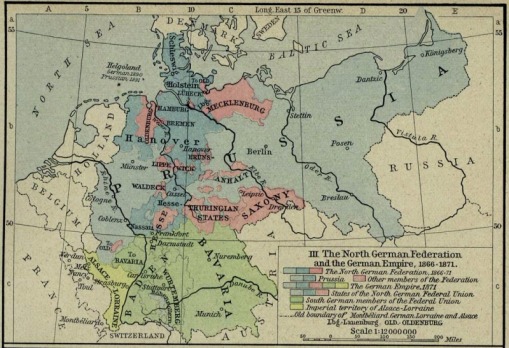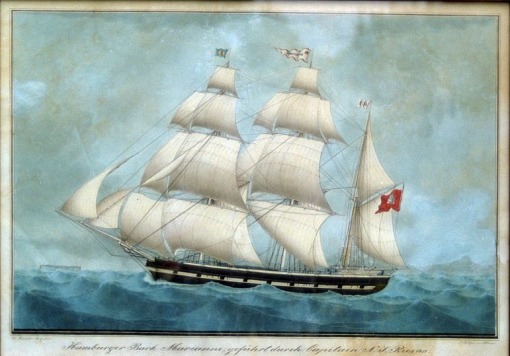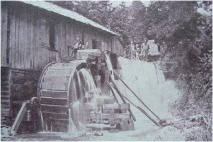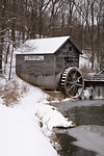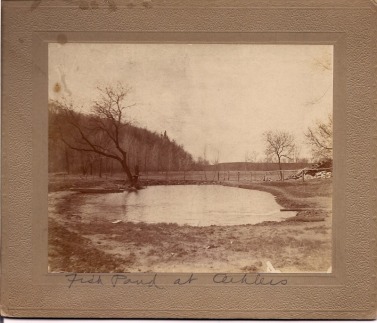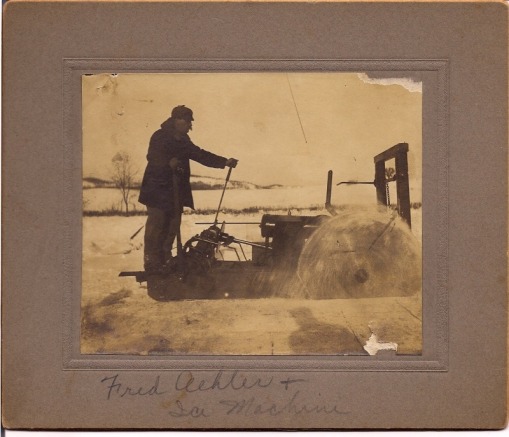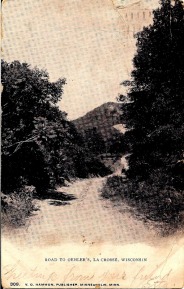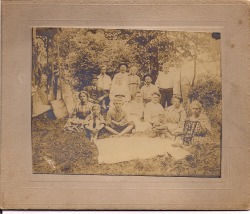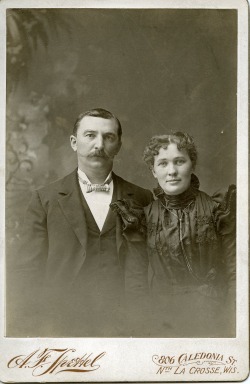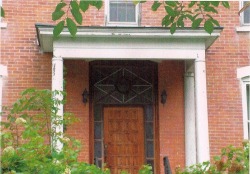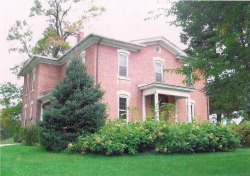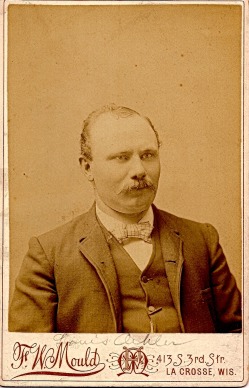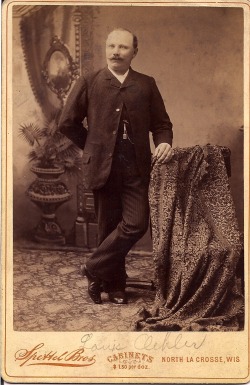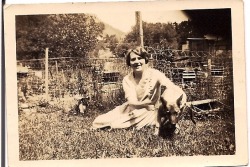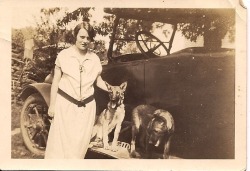Time line of the Oehler Mill, 1841 to present.
First Mormons in La Crosse, 1841.
A group of Mormons temporarily came north in 1841 to obtain lumber to send down stream to their settlement at Nauvoo, IL (400 miles south of La Crosse, WI). Their stories of the fertile valleys of La Crosse convinced a group of Mormons in 1844 to travel to Mormon Coulee to set up a settlement.
Mormon group sets up a settlement in La Crosse, 1844.
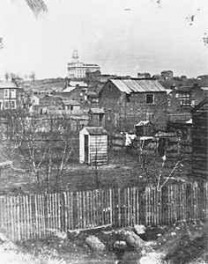
Nauvoo, IL 1846
In 1844, a group of Mormons under the leader Elder Lyman Wight traveled from Nauvoo, IL and settled on what would be the Oehler Mill site (6 miles south of La Crosse, WI). The creek on the land is still called Mormon Creek and the surrounding area is called Mormon Coulee. The 20 families built 25 to 30 log houses and spent the winter. Two Mormons, Asher and Effelender Gressman called the the creek, "the best mill site I ever saw." They claimed by "building a dam a hundred feet long you can raise the water forty feet high if you choose. The stream is about twelve feet wide and will average two feet deep at any season of the year, with a rapid current and the best water I ever drank." The Mormons left in the spring and proceeded with earlier plans to travel to Texas. They burnt the houses down before they left. The Mormons may have left due to poor treatment by local residents who were fearful of their religion. This unfortunately was a common occurrence for Mormon travelers who were driven out of many towns and cities throughout the nation. The La Crosse Mormons more than likely built a mill on the site because after their departure a lime kiln and pieces of mill-stone were found embedded in the creek.
Valentine Oehler travels to the US, 1854.
As the oldest son, Valentine traveled to the United States before the rest of the family followed him in 1855. He may have traveled with his sister Marie. Valentine arrived in La Crosse via Milwaukee. It is not known why the Oehlers settled in the La Crosse; they may have settled in La Crosse because many German immigrants from the southeastern part of Germany were already living in the La Crosse area. In the time period 1820 to 1871, many Germans emigrated due to economic hardships, including unemployment and crop failures. Some Germans also left to avoid wars and military service. In some cases, government entities encouraged poor citizens to emigrate. Sometimes money for travel was provided to emigrants. Church records indicate that the Oehlers were given food and money to travel to the United States because of the economic depression. The 1820 to 1871 wave of German immigrants, most often settled in Ohio, Wisconsin, Indiana, Missouri, and Texas.
Oehlers get an emmigration permit March 22, 1855.
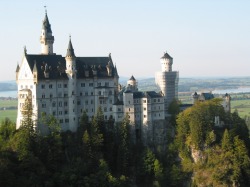
German castle
Jacob Oehler (handicraftsman of Krobern, Altenburg, Saxony, Germany) and his family were granted an emigration permit by the Duke's court. Emigration permits were required by the government for the following reasons:
1. To have a legally valid declaration of the abandonment of citizenship;
2. To make sure that passports were not issued to young men under conscription;
3. To prove that the emigrants had sufficient travel funds, so Germany would not have to support emigrants who ran out of money ;
4. To make sure that the emigrant didn't have any unpaid debts before leaving;
5. To make sure that emigrants under age had sufficient protection by accompanying adults and were protected at their place of settlement;
6. To collect data for statistical purposes.
The emigration permit for the Oehler family states that Jacob Oehler may return to his homeland provided that he has not obtained citizenship, has no military obligation, and has not acquired any other debts or obligations.
1. To have a legally valid declaration of the abandonment of citizenship;
2. To make sure that passports were not issued to young men under conscription;
3. To prove that the emigrants had sufficient travel funds, so Germany would not have to support emigrants who ran out of money ;
4. To make sure that the emigrant didn't have any unpaid debts before leaving;
5. To make sure that emigrants under age had sufficient protection by accompanying adults and were protected at their place of settlement;
6. To collect data for statistical purposes.
The emigration permit for the Oehler family states that Jacob Oehler may return to his homeland provided that he has not obtained citizenship, has no military obligation, and has not acquired any other debts or obligations.
Public notice posted in Altenburg Germany announcing the departure of the Oehlers, April 4, 1855.
The house owner Gottfried Proehl was advised of the departure of the Oehlers, and the landowner Johann Koehler was granted power of attorney for the two children born out of wedlock to Sophie Oehler and Christine Oehler named Albertine and Berta Oehler. Berta Oehler was not included on the ship's manifest that her mother traveled on. It is unknown what happened to Berta Oehler.
Valentine buys land in Mormon Coulee, 1855.
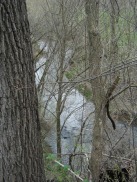
Mormon Creek
Valentine purchased 40 acres of land from James Conlan for $1400.
Rest of Oehler family travels to US, July 18, 1855.
Gottfried (age 30) traveled to the United States with the rest of his family: Jacob (father age 57) and Justine (mother age 55), Christine (sister age 28), Sophie (sister age 24), Ernst (brother age 21), Franz (age 17), and child of Sophie (Alvine or Albertine, 18 month old, niece). They left from Bremen, Germany and traveled to Baltimore, Maryland aboard the Marianne (Baltimore, Maryland was a popular port for Germans traveling from Bremen to the United States, this was due to commercial activity between the two cities). Bremen became one of the busiest ports for millions of emigrants leaving central and eastern Europe and going to America. Bremen is located on the banks of a large river that flows into the North Sea. The Oehlers traveled in steerage and their occupation was listed as millers. The ship manifests lists their last residence as Croben/Krobern. On the voyage the 18 month old child died of dropsy. She was the only death on the ship. The Oehlers destination was listed as Wisconsin. They brought 9 boxes of luggage with them.
Stone dam built, 1857.
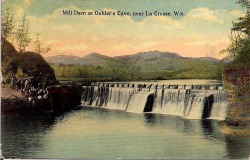
A stone dam and earth dike system was built by the Oehler brothers, Gottfried and Valentine. The brothers carved out a small cave by hand, on what would be the left side of this picture, in order to let excess water flow through.
First mill built by Oehlers, 1857.
The first mill was built as a saw mill, and it was later converted to a grist and flour mill in 1858. The brothers built a larger, more permanent, and strictly flour mill in 1862.
The stone mill built, 1862.
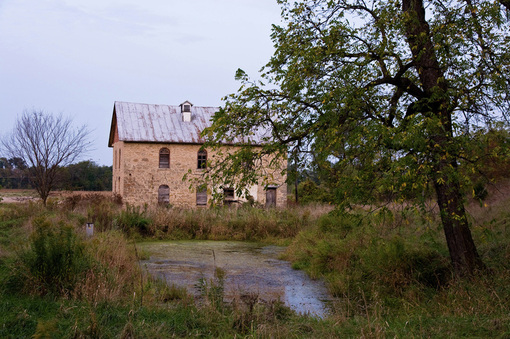
Current photo of the mill and pond. Photo courtesy of Joann M. Ringelstetter http://www.shunpikingtoheaven.com
The stone mill that is currently standing on the site is built. It has three run of stone and is two-stories high. The mill was built before roller mill technology came to the area in the 1880s.
Gottfried buys land, 1870.
Gottfried purchased 28.5 acres of land from his brother Valentine. He also bought an additional 29 acres from John Gustave and Fred Oehler. In 1873, Gottfried buys another half acre from Valentine. Gottfried then has a total of 29.75 acres of the original land bought in 1855, while Valentine retains 10.25 acres of the original land.
Gottfried Oehler joins Methodist Church, 1860s/1870s.
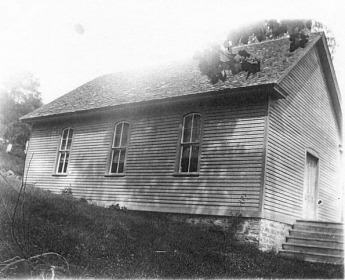
Photo of the church circa 1875
Gottfried Oehler joins the near-by German Methodist church in Chipmunk Coulee (10 miles southeast of La Crosse). Most members of the church are German immigrants from northern Bohemia. The church gathered in a log school house until a wooden church was built in 1862. The preacher would travel in from La Crosse by horse and buggy. There is also some evidence that the Oehler's were involved with the Evangelical Lutheran Church. Three of Gottfried's children are noted in the Evangelical Lutheran Church's burial records (Emma, Charlie, and Louis). Margaratha's, wife to Gottfried, religion is unknown. Louis's daughter, Margaret Oehler Davidson was a Methodist for her entire life.
Root cellar built, July 1876.
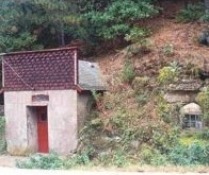
Notice the window on the right side.
The root cellar located across the street from the brick homes was built in 1876. The cellar was hand-carved directly into the sandstone bluff; it contains a window and a chimney. The root cellar's large size makes it quite unusual. At some point in time brick supports were added. Root cellars served as a primitive form of refrigeration. When Joseph Jahnel brought the property, he added electricity to the cellar. According to memory, there may have been an ice house on the mill, but no photos exist. However, there is a photo of Fred Oehler cutting ice with an "ice machine."
Valentine's brick home built, circa 1880.
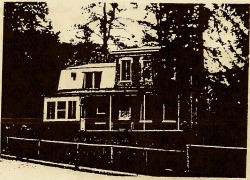
Valentine's House
Both Oehler brothers, Gottfried and Valentine, built houses out the same local red brick. Valentine's house is a two-story brick cube house, and is still lived in today.
Louis and Fred Oehler buy land, 1882
Gottfried's sons Louis and Frederick bought 10.25 acres of land from Valentine for $2000.
Valentine Oehler dies January 5, 1891.
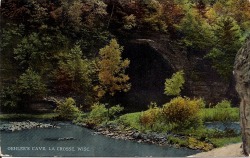
Oehler's Cave Postcard
Valentine was born June 9, 1821 and came to the United States from Saxony, Germany in 1851. He died in his home in Mormon Coulee of bronchitis and/or paralysis of the heart. He owned half the Oehler Mill business for 19 years; later he sold his halfof the business to his brother Gottfried and started farming. On the 1880 census Valentine had a farm laborer by the name of James R Lucas (age 26 born in Kentucky) living with him and his family. Valentine was an assessor and also treasurer of the town. He was also a member of a La Crosse Lodge of Odd Fellows and a member of a Masonic lodge.
Valentine married at least four couples (one, his brother Gottfried in 1858, two, August/Gottheif Hedwig/Herold and L.E. Fredricka Lauterbach on May 15, 1859 in the home of the Lauterbach's, the witnesses were Julius Justin and Louis Justin -currently the next road down from the Oehler Mill is Justin Road-, three, Catharia Strubel and Blase Schramm on September 28, 1858 with witnesses Stuton Proksch and Geyer Biegle, and four, Joseph Reiple and Gretchen Eppenberger with witnesses George Reiple and Gottfried Oehler). Valentine had four children. His son F. Albert Oehler was a successful boot and shoe dealer in La Crosse. His son L. Edward Oehler moved to Milwaukee and may have worked for Briggs and Stratton. None of Valentine's children continued the family tradition of milling.
Valentine married at least four couples (one, his brother Gottfried in 1858, two, August/Gottheif Hedwig/Herold and L.E. Fredricka Lauterbach on May 15, 1859 in the home of the Lauterbach's, the witnesses were Julius Justin and Louis Justin -currently the next road down from the Oehler Mill is Justin Road-, three, Catharia Strubel and Blase Schramm on September 28, 1858 with witnesses Stuton Proksch and Geyer Biegle, and four, Joseph Reiple and Gretchen Eppenberger with witnesses George Reiple and Gottfried Oehler). Valentine had four children. His son F. Albert Oehler was a successful boot and shoe dealer in La Crosse. His son L. Edward Oehler moved to Milwaukee and may have worked for Briggs and Stratton. None of Valentine's children continued the family tradition of milling.
Fire at Gottfried Oehler house, 1883.
On May 12 and May 13, 1883, articles appeared in the La Crosse Republican and Leader and the La Crosse Chronicle about a fire at the Gottfried Oehler house. The Republican reported on May 12 that the house of Gottfried Oehler, "the well-known miller of Mormon Cooley, was burned to the ground last night between two and three o'clock. The house and contents were entirely destroyed. There was no insurance and the loss falls heavily upon Mr. Oehler. The fire is supposed to have been the work of an incendiary. No fires had been in use in any part of the house, and no origin of the flames can be given except in the theory that some enemy of Mr. Oehler's deliberately burned him out. The fire had professed so far before before its discovery that Mr. Oehler and his family had a narrow escape from death in the flames, having barely time to flee from the house in their night clothes."
The Chronicle's May 13th account leaves out the theory of an enemy setting the fire, instead saying that "between one and two o'clock yesterday morning the dwelling house of G. Oehler situated near his mill in Mormon Coolie, caught fire from some unknown cause and was totally destroyed with all the contents. Mr. Oehler's story as it reaches us through his neighbors, is that he was awakened by an explosion, rose and opened up the door and was instantly enveloped in flames which spread so rapidly that he had barely time to rouse his family and get them out. The house was a two store [sic] frame structure. Mr. Oehler had no insurance either on building or contents."
The Chronicle's May 13th account leaves out the theory of an enemy setting the fire, instead saying that "between one and two o'clock yesterday morning the dwelling house of G. Oehler situated near his mill in Mormon Coolie, caught fire from some unknown cause and was totally destroyed with all the contents. Mr. Oehler's story as it reaches us through his neighbors, is that he was awakened by an explosion, rose and opened up the door and was instantly enveloped in flames which spread so rapidly that he had barely time to rouse his family and get them out. The house was a two store [sic] frame structure. Mr. Oehler had no insurance either on building or contents."
Gottfried Oehler builds brick house, 1880s.
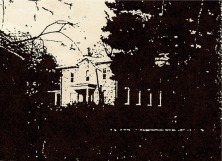
Gottfried's House
In the 1880s, Gottfried Oehler builds the ten room house that still stands on the site today.
Gottfried Oehler dies October 4, 1895.
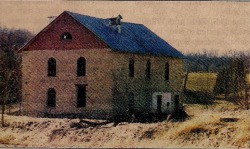
Modern Photo of the Mill
Gottfried was born on April 15, 1825 in Germany, and he traveled to the US in 1855. He married Margaretha. Gottfried died of disease of the heart and was buried in the family cemetery.
The mill gets passed down, 1895.
The mill was passed down upon Gottfried Oehler's death to his son Louis in 1895. In 1895, Louis was 35 years of age and sported a large mustache. Louis' son Elmer may have raised German Shepherds on the mill for a period of time.
Fred Oehler and John Gustave buy land, 1908.
In 1908, Fred Oehler and John Gustave buy three parcels of land from Louis Oehler for $1600.
The State Normal School Botany Class at Oehler Cave, 1913
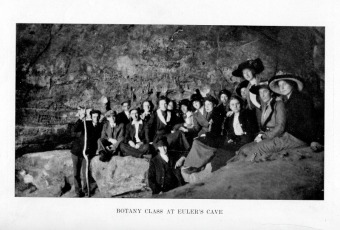
This photo appears on page 89 in the State Normal School's (then a teaching college, now the University of Wisconsin-La Crosse) yearbook, the Racquet, in 1913. It is unknown whether this was a yearly activity for the botany class. Photo courtesy of Murphy Library Special Collections and Area Research Center, University of Wisconsin-La Crosse.
The end of Red Rose Flour, 1918.

The last Red Rose Flour was produced at the mill in 1918. Farmers while waiting for their flour to be ground often enjoyed the park and cave.
Oehlers lose family mill, 1922.
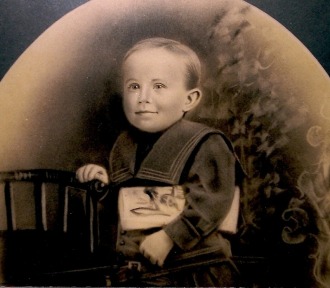
Childhood photo of Elmer Oehler
According to family memory, Louis Oehler lost the mill because of his efforts to help a struggling friend with a mill in Minnesota. Louis put his mill up as collateral and ended up losing the mill, while his friend in Minnesota was somehow able to keep his. It is also believed that Louis may have been taken advantage of by the banker due to his poor English abilities. Louis' son Elmer Oehler (a 1918 graduate of La Crosse High School and about 23 years old in 1922) attempted to help his father with the business deal, but memory says Louis was too proud to accept his son's help. Elmer in a last resort effort attempted to sell off all valuables in order to save the mill. He even sold frames that held the family's photographs.
Louis Oehler dies, June 1928 (son of Gottfried Oehler).
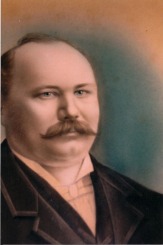
Louis Oehler
Louis Oehler died at age 69 after being ill for about a year. He took over the milling operations from his father Gottfried Oehler. Louis Oehler also owned in part and operated for 14 years the Chaseburg Roller Mill. He left behind one son Elmer Oehler, two daughters Margaret Davidson and Evelyn Oehler, and a brother John Oehler (who owned a mill in Rushford, MN). He was buried in the family cemetery on County Road MM.
Wenzel Herlitzka, 1930.
In 1930, Wenzel Herlitzka gained control of the Gottfried Oehler property for $1950; the land assessed at $4250 in 1867. In 1936, Herlitzka sold the site to his son-in-law Norbert Betz for $526. In 1950, Norman's wife Anna Betz owned the property and sold it to Robert and Lucille Swing for $1 and other considerations. The home is still owned by Lucille Swing.
Joseph Jahnel.
After the Oehler family lost the mill in 1922, the Valentine Oehler section (10.25 acres) was purchased by Joseph Jahnel. To this day, the proptery is still owned by a Jahnel, Lillian Jahnel daughter of Joseph Jahnel. She took possession of the home in 1972.
Flood, 1941.
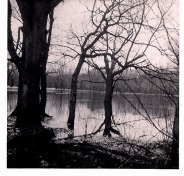
September 14th, 1941 brought torrential rains flooding many creeks and streams throughout the area including Mormon Creek. This flood washed out part of the dike, but the stone dam remained undamaged. It was built so water could flow over top of the dam during floods. However, built up silt had caused the dam to no longer hold back the creek.
Swings buy Gottfried Oehler House, 1950.
In 1950, Robert and Lucille Swing buy the Gottfried property for $1 and other considerations from Anna Betz. The home is still owned by Lucille Swing. The Swings obtained 112 acres of land along with the house. On the land is the park site, the dam, the Gottfried house, the mill pond, the cave, and the mill.
Flooding damages the dam site, 1950.
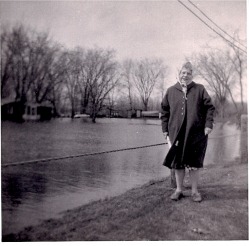
Margaret (Oehler) Davidson in 1965 La Crosse flood.
The majority of the stone dam was destroyed by a massive flood in 1950.
Picnics, 1950s.
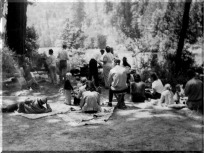
Generic 1950s picnic
Under the ownership of Robert Swing, the Oehler Mill hosted many gatherings slightly reminiscent of past times, when the farmers would enjoy the park and cave while their grain was turned into flour. Church groups, businesses, and social clubs were among the park goers. Some specific groups include the Coulee Region Barber shoppers, the Muzzle loaders, and Heileman's. According to Robert Swing in a 1992 interview for the La Crosse Tribune the park would host "20 picnics a summer on weekends" and "several thousand people" would visit the mill each year. Robert Swing's poor health put an end to the gatherings.
National Registry of Historic Places?, 1992.
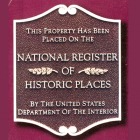
Robert Swing wanted to place the Oehler site on the National Registry of Historic Places, but poor health halted his pursuit.
Robert Swing dies, 1994.
Swings donate land to Catholic Church, 1999.
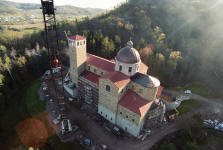
The Shrine Church under construction
Current owner Lucille Swing and her late husband Robert donate the land north of the mill (includes the dam, cave, and park) to the Diocese of La Crosse. The Church hopes to build a shrine on the land.
Catholic Church begins building the shrine, May/July 2001.
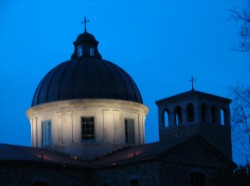
Night view of the Shrine
Ground breaking ceremony held on May 30, 2001 to build a 25 million dollar shrine on the Oehler land in honor of Our Lady of Guadalupe (the virgin Mary). Link to the Shrine's website.
Mill placed on the endangered list, 2002.
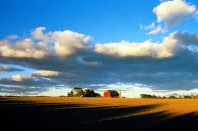
Generic picture of Wisconsin
The Wisconsin Trust for Historic Preservation placed Oehler Mill on its list of 10 most endangered historic properties in 2002. The trust states that the mill "stands in a prime area for development, rezoning, and urban encroachment."
Plein Air Artists travel to paint Oehler Mill, 2006.
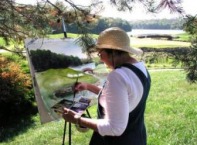
Generic plein air painter
In 2006, the Plein Air Artists of the La Crosse area travel to County Road MM in order to paint artwork of Oehler's Mill.
Further preservation work, 2010 - present.
A grant from the Wisconsin Historical Society was awarded to the La Crosse County Historic Sites Preservation Commission (a commission of the La Crosse County Board) to do further research and complete a Register of Historic Places nomination for the historic "Oehler Rural Farmsteads Historic District." The nomination included the entire Oehler Mill complex: two houses, outbuildings, the mill, the cave, and the cemetery. The nomination was constructed in 2010 and completed in early 2011. The nomination was accepted and can be viewed on the National Park Service website here: https://www.nps.gov/nr/feature/places/13000314.htm
